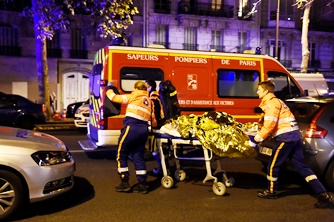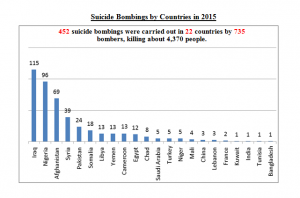Publications
INSS Insight No. 789, January 26, 2016

Over the past two decades, suicide attacks have become a prominent weapon in the arsenal of terrorist organizations in general, and Salafi jihadist organizations in particular. With rare exceptions, the suicide attacks that took place in 2015 were committed by terrorist organizations associated with radical Islam. Although suicide attacks constitute only a relatively small proportion of terrorist organizations’ operations, the number of these attacks, as well as their geographic distribution, has grown over the years. The increasing use of suicide attacks results from the numbers of lives they claim, and their ability to establish deterrence and create an impression of power for the organizations behind this form of terrorism – demonstrating to everyone the willingness of group members to make the ultimate sacrifice in an effort to achieve their goals.
Suicide attacks figure in the statistics regularly compiled by the Institute for National Security Studies. These statistics are based on at least two independent sources, taking into account that more than a few reports are disseminated by organizations seeking to glorify their activity; for this reason, unverified reports are not included in the statistics. In addition, a combined attack conducted simultaneously against a number of targets simultaneously is counted as a single event (e.g., the attack in Paris on November 13 was counted as one attack). These principles guided the counting of suicide attacks that took place during 2015 throughout the world – some 452 attacks carried out by some 735 male and female terrorists in 22 countries. These attacks claimed the lives of approximately 4,370 people.
While this figure reflects a decline of 24 percent from 2014 – when 592 attacks were carried out by 937 terrorists in 16 countries, causing the death of approximately 4,400 people – it indicates that the suicide attacks in 2015 were deadlier than those carried out in the preceding year. The numerical decline in 2015 resulted from a noticeable reduction in suicide attacks in Iraq and Afghanistan – the two main countries in which most of the suicide attacks in previous years were carried out. On the other hand, there was a distinct rise in suicide attacks in Africa, mainly in Nigeria, as well as in several neighboring countries.
Principal Trends
a. The Middle East remained the main theater of activity for suicide terrorism in 2015, with 452 suicide terrorists carrying out 207 suicide attacks in the region. The decrease in the number of attacks committed during the year in question – 44 percent, compared with the preceding years, in which there were 370 suicide attacks – was due primarily to a drop in the number of suicide attacks in Iraq (115 in 2015, compared with 271 in 2014), Yemen (13, vs. 29 the previous year), and Lebanon (3, compared with 13). In Syria, on the other hand, the trend remained stable (39 in 2015, compared with 41 in 2014). The number of suicide attacks rose in Egypt (12, compared with 4) and Libya (13, compared with 11).
b. The number of suicide attacks in Africa soared 157 percent in 2015. Most of these were committed in Nigeria by Wilayat West Africa (a combination of Boko Haram and Ansaru), which was responsible for 122 suicide attacks carried out by 213 terrorists. 96 of these attacks took place in Nigeria (compared with 32 attacks in 2014), and the rest in Cameroon (13), Chad (8), and Niger (5). This increase can be attributed to the organization’s response to the offensive against it by a coalition of African countries, which greatly reduced the territory controlled by the organization, and also to a response to the declaration of war against the organization by new Nigerian President Muhammadu Buhari (February 2015), who declared his intention of defeating Wilayat West Africa. At the same time, the Somali organization al-Shabaab, a member of al-Qaeda’s network of alliances, was also active in 2015, carrying out 18 suicide attacks (compared with 19 in the preceding year).
c. The number of suicide attacks carried out by women rose sharply in 2015. 124 women committed 70 attacks, 66 of which were carried out on behalf of Wilayat West Africa (Boko Haram and Ansaru) by 120 women, including 35 by children and girls (compared with only 13 suicide attacks by women in 2014). This figure highlighted the dramatic rise in suicide attacks by women in Nigeria (50) and Cameroon (11). Women committed three terrorist attacks in Chad, two in Niger, and one each in Somalia, Turkey, Afghanistan, and India.
d. In 2015, the Islamic State was prominent in terrorism in general and in suicide terrorism in particular, responsible, directly or indirectly, for 174 suicide attacks. The Islamic State took responsibility for 75 suicide attacks, while 74 others, which took place in Iraq or Syria, were attributed to it, although the Islamic State did not claim responsibility for those attacks. 134 more suicide terrorist attacks were carried out by the Islamic State’s partners in Nigeria (Wilayat West Africa) and Egypt (Wilayat Sinai).
e. The number of suicide terrorist attacks in two key theaters in southern Asia, Afghanistan and Pakistan, fell. 96 terrorists committed 69 suicide attacks in 2015, compared with 124 in the preceding year – a 44 percent drop. It appears that the withdrawal of the American forces from Afghanistan led the Taliban organization to focus its efforts on conquering territory in strategic areas, instead of on terrorist attacks, including suicide attacks in cities. The number of suicide terrorist attacks in Pakistan also fell: 31 suicide terrorists carried out 24 attacks in 2015, compared with 36 attacks in 2014 (a 33 percent decrease).
One outstanding event in this context in 2015 was the carrying out of a number of suicide attacks in Europe. The most dramatic was the November 13 attack in Paris by carried out by seven suicide terrorists, who killed 130 people and injured hundreds. The attack was launched by the Islamic State, mainly by French and Belgian citizens of Muslim origin, who returned to Europe after being recruited and trained by the organization. The Islamic State also carried out three suicide terrorist attacks in Turkey (of the five that took place in that country in 2015). The most deadly of them (103 civilians killed) targeted pro-Kurdish activists.
Clearly, then suicide attacks continue to be both a functional and symbolic means of warfare for many large Salafi jihadist terrorist organizations operating throughout the world, and is spreading to new countries. The principal elements behind suicide terrorism are organizations identified with the global jihad idea, most of which were formerly affiliated with al-Qaeda and which are now primarily affiliated with the Islamic State.
With the intensification of the ongoing campaign against jihad terrorism in the Middle East, Africa, and Europe, in the Middle East these groups now face a broad international coalition. Ethnic conflicts and conflicts between Islamic factions, mainly in the Middle East, are also escalating, and it is therefore expected (with all due caution) that suicide terrorism will continue to be a significant part of the methods employed in the framework of these struggles. The number of suicide bombers and attacks will be determined by the results of the equation: on one side, the capabilities of the various organizations using this method of warfare, and against them, the determination and capability of the security forces and intelligence services of the countries trying to thwart such attacks.
Once again Israel was not a prominent target for suicide attacks in 2015. Most of the terrorist attacks against Israelis were knifings, car rammings, and gangs bearing firearms. The few isolated attempts to carry out suicide attacks were foiled. However, whether the violent conflict between Israel and the Palestinians that erupted in the fall of 2015 continues or wanes, attempts to escalate or reignite it using highly publicized suicide attacks are likely to occur. At the same time, Salafi groups affiliated with the Islamic State or with al-Qaeda have made clear and explicit threats to carry out terrorist attacks against Israel – including suicide attacks within its borders and throughout the world.

Click here for a breakdown by country and analysis of suicide attacks in 2015.
For the full 2015 suicide attacks database - click here.
____________________________________________________________
We would like to thank Tali Debi Rotschild, Smadar Shaul, Noa Zalsman, Av Baras, Aviad Mendelboim, Keren Abrevaya Erez, and Afik Barak, who work in the INSS Terrorism and Low Intensity Conflict research program, for their contribution in collecting the data.


